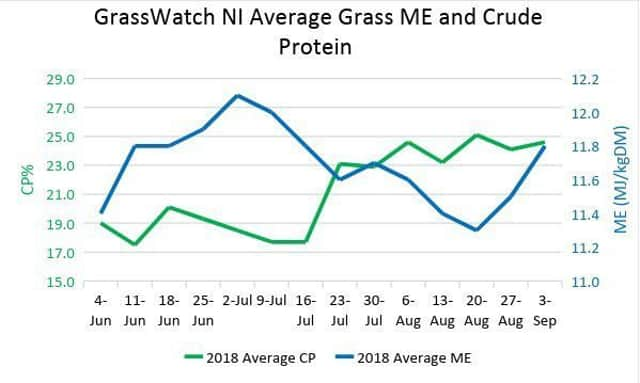GrassWatch shows recent grassquality is still good


Over the past few weeks, the GrassWatch monitor farms have continued to show high grass growth rates, with the average pre-grazing grass covers consistently greater than 4,000kgDM/ha. Grass metabolizable energy (ME) has varied each week within the range of 11.3 and 11.8 MJ/kgDM, with a general decreasing trend since the start of the project in June.
Despite the common perception that grass crude protein (CP) is high during spring, the monitor farms have shown that the average grass CP is still between 23% and 25% at present. Although grass CP does vary between farms, there is no strong relationship between timing of fertiliser application and grass CP. Some paddocks where fertiliser was applied after grazing showed a larger CP range with higher values. As CP is still relatively high, it is important to continue monitoring protein levels into the autumn by assessing milk urea nitrogen and dung scores. If you have any uncertainty about protein content of cow diets, contact your local compounder’s nutritional advisor.
Advertisement
Hide AdAdvertisement
Hide AdAs many farms have less forage stocks this winter, careful management of Autumn grazing will be important to maximise forage utilisation. Ideally, grass should remain in milking cow diets for as long as possible to reduce reliance on winter silage supplies. However, as grass quality may decrease later in the season, less energy will be provided from grass. Increasing concentrate supplementation may then be necessary to compensate for any shortfall in energy, or if there is a shortage of grass when growth rates slow.
When grass supply begins to decrease, buffer feeding will help to maintain dry matter intakes. Grass dry matter on the monitor farms has been decreasing from an average of 20% during early August to 13.3% at present, with one farm experiencing a low of 11%. Feeding good quality grass silage will continue to encourage intakes. If silage is in short supply, use of alternative forages and additional concentrates may be used also – remember, cows only need seven to 8kgDM/day from forage to maintain a healthy rumen.
Aim to start closing paddocks by 10th October, with 60% of grazing platform closed by end of the first week of November. It is vital when paddocks are closed that they have been grazed out well to around 3.5–4cm. This will encourage winter tillering and promote better quality growth for the next grazing season. If milking cows are unable to graze paddocks to sufficient residuals, dry cows or young stock may be grazed behind them to help achieve this. Very heavy paddocks could still be baled; however care should be taken with this method once the grass growth rates decrease.
GrassWatch has been a valuable project this summer given the difficult conditions. It has provided an insight into how grass quality changes throughout the season and highlighted key areas to alert farmers of potential risks to their cow’s milk production.